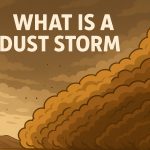Dust is all around us—on furniture, in sunlight beams, and even floating through the air we breathe. Although it seems like a minor annoyance, dust plays a major role in the environment, health, and even weather. Understanding dust can help us improve indoor air quality, reduce allergies, and better appreciate its role in nature.
What Is Dust Made Of?
Dust is a mixture of tiny solid particles that come from a wide range of sources. Common components include:
- Dead skin cells from humans and animals
- Hair and textile fibers from clothing, rugs, and furniture
- Soil and pollen from outdoors
- Mold spores, bacteria, and viruses
- Insect droppings and body parts (like those from dust mites)
- Pollution particles from factories or vehicles
- Microplastics in urban environments
Depending on where you are, the composition of dust can vary greatly.
Where Does Dust Come From?
Dust has both indoor and outdoor sources:
- Indoors, it mostly comes from people, pets, fabrics, and activity.
- Outdoors, wind stirs up soil, sand, plant matter, and pollutants, which then enter homes through windows, doors, or ventilation.
- In cities, construction sites and traffic are major dust contributors.
Dust is also carried by the wind across entire continents—for example, Saharan dust can travel across the Atlantic Ocean to reach the Americas.
Is Dust Harmful to Health?
Dust isn’t just a cleaning problem—it can affect your respiratory system:
- Allergens in dust, like pollen and dust mites, can trigger asthma or allergies
- Mold spores and bacteria may cause infections in sensitive individuals
- Tiny particles, especially in polluted air, can enter the lungs and bloodstream
- Children, the elderly, and people with existing health issues are most vulnerable
Good cleaning habits and air filters help reduce health risks.
Dust in Nature and Science
Dust also plays a role in natural processes:
- Dust in the atmosphere can affect climate by blocking or scattering sunlight
- Dust particles serve as nuclei for raindrops to form
- In space, cosmic dust helps form stars and planets
Volcanic eruptions, deserts, and wildfires all release natural dust into the atmosphere.
How to Control Dust Indoors
To reduce dust buildup in your home:
- Vacuum regularly, especially carpets and upholstery
- Use a HEPA filter in vacuums and air purifiers
- Dust with a damp cloth to trap particles instead of spreading them
- Wash bedding and curtains often
- Limit clutter, which collects dust easily
- Maintain good ventilation and clean air ducts
Reducing indoor dust improves air quality and comfort.
Glossary
- Dust mites – Tiny insects that feed on skin flakes and live in household dust
- HEPA filter – A high-efficiency air filter that traps very small particles
- Microplastics – Tiny plastic particles that come from broken-down plastic waste
- Pollen – Fine powder from plants that causes seasonal allergies
- Airborne particles – Solid or liquid substances suspended in the air


